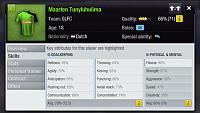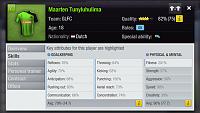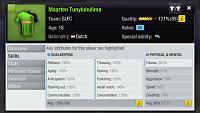 35Likes
35Likes
-
I have done some more testing to understand the relationship between training speed and the levels of the skills being trained. Here is my test subject:

I got him from auction on the first day of the season and trained his SA with repeated sets of Lv4 6x Sprint (I have maxed out my training level, so all drills are Lv4). He gained exactly 2 SA points from each set, which translated to 5.3 Skill% / rest (2 x 4 x 15 / 22.5).
Part 1
To figure out how the current level of an attribute affects its training speed, I gave him repeated sets of 6x Wing Play. The reason I chose Wing Play was that it trained precisely one of his white skills (Punching) and nothing else. I thought this was the simplest way to determine his training speed as a function of skill level. I knew beforehand that gains would be high at first and then gradually slowed down before coming to a near halt around 140%. I also knew that training speed under the new system was independent of a player's overall quality, so I did not bother recording it as the experiment went along.
Here is the result:

The second row indicates the amount of % in Punching gained per set of 6x Wing Play, and adding it to his starting % in the above entry in the first row gives the current % after the set. The main takeaway here is that his training speed slows down each time he has gained 20% in Punching. For instance, he averages 6.7% per set when Punching is between 60% and 79%, and 5% per set between 80% and 99%. The gain per set has slowed to 1.3% after 140%, and I decided to stop at 150%. To summarize,

Note that this table agrees with Al Svanberg's guide under the previous training system (see post #59, divide the last column in the table above by 15 to get his chart):
https://forum.topeleven.com/tutorial...ng-system.html
Part 2
The problem with Part 1 is that none of the training drills cover only one skill for outfield players. For the other ten guys, each drill trains at least 2 attributes. To address this issue, the next phase of this experiment involves repeated sets of 6x Slalom Dribble. I decided on this because it trains one each of white skill (Fitness) and grey skill (Speed) and nothing else. This way, I can at least determine training speed as a function of the average of the two skills being trained.

Rows 3,4 and 5,6 are similar to those in the first tables. Row 1 gives the average of the two skills being trained and row 2 is the total Skill% gained from each session. As you can see, training gains drop each time the average of the two attributes have increased by 20% just like in Part 1. Again, to summarize,

This table agrees with the second table up to sampling errors (The first rows for 60%-79% differ from each other more due to small sampling size). The key message here is that training gains depends on the average of the skills being trained. More precisely, training gains slow for each 20% gained in the average of the skills. This is my player after the above two series of training:

Part 3
The last question is: how to train players under the new system? I do not have the best answer here, but I can share what I have done and plan to do in the near future. After training my test player with the above two sets of drills, I did 1-On-1 Finishing, GK Training and One Line of Defense to cover the other nine white skills that had not been trained yet.

I kept the average of the skills being trained by a given drill under 140%; otherwise progress would slow down considerably. I stopped when his overall quality went just above 120% like I did when I power-trained by my players before the new update. I used about 300 rest packs from start to finish, which would more or less be the amount I needed under the old system. In fact, his skills would probably be more or less the same had I trained him under the old system.
The main issue now is that for the past few seasons, I have picked up one 18 y.o. per season and planned on keeping each player for 11 years. As the seasons go by, I can see how it would be increasing difficult to train a player’s white skills. As the white skills have gone above 140%, I would have to train him with drills that cover both white and grey skills like I did with Slalom Dribble in Part 2.
Conclusion
If you want to know how fast a player trains, ignore his overall quality. Instead, treat each individual skill as having its own star system (60%-79%=4*, 80%-99%=5* and so on). When a drill covers multiple skills, take the average of the skills being trained. Just like before with the star system, the more stars the skill average has, the slower your player will train.
Tags for this Thread
 Posting Permissions
Posting Permissions
- You may not post new threads
- You may not post replies
- You may not post attachments
- You may not edit your posts
-
Forum Rules


 35Likes
35Likes LinkBack URL
LinkBack URL About LinkBacks
About LinkBacks









 Reply With Quote
Reply With Quote
